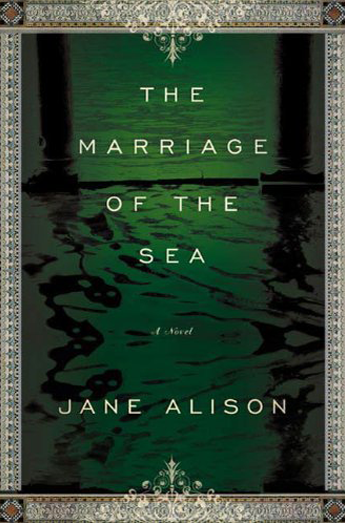 “Ambitious, complex, challengingly intellectual… a creation of real beauty…. A real achievement.” — Kirkus Reviews (starred review)
“Ambitious, complex, challengingly intellectual… a creation of real beauty…. A real achievement.” — Kirkus Reviews (starred review)
In a damp Venetian palace, Oswaldo contemplates the ravages of time to his body and his beloved city, and dreams up a way to hold mortality at bay. In New York, Lach steps out into the crisp, clear night to savor his new freedom, having just dropped Vera to join his new love, Francesca, in Venice. In rainy London, Max packs for a precipitous move to New Orleans, in pursuit of Lucinde, a woman he barely knows. From New Orleans, Lucinde flies to the aid and comfort of Vera, who, betrayal or no, has accepted a grant to go paint in . . . Venice. And elsewhere in the Crescent City, Anton, leaving to seek his big break in that other renowned city of water—Venice, of course—sketches a good-bye upon the slumbering body of his wife, Josephine.
With wit, sympathy, and surpassing deftness, Jane Alison choreographs an intricate minuet among these characters, whom love and loneliness, aspiration and desperation, have drawn to two famously romantic, venal, and elusive cities of water.
Reviews
 Booklist
Booklist
Water dominates the imagery of this unorthodox and complex novel, which takes the reader inside the minds of six characters and blends them fluidly into interaction. Oswaldo’s beloved Venetian villa is decaying around him, and his aging body is also in the throes of its own irreversible transition. Anton and Josephine are distraught over the watery blackness of Josephine’s womb, which rejects all of their efforts to begin a family. Lach and Vera have reached the end of their marriage, and thoughts of a life in Venice with his newly found lover are at the forefront of Lach’s plans. Max has traveled across the world from London to the misty banks of Louisiana to pursue the elusive and beautiful Lucinde.
A kind of cleansing washes over the lives of Alison’s characters, which is in keeping with the liquid landscape she has crafted for them. It is Alison’s razor-sharp technique for incorporating the essence of her backdrop into the personalities dominating her fiction that makes this a uniquely flavored novel drawn from a refined talent.
Kirkus (Starred Review)

Readers of Alison’s wondrous bringing to life of Ovid (The Love-Artist, 2001) will find here the same highly controlled lushness in a contemporary story that starts slowly but gains power. In the manner of Michael Cunningham’s The Hours, with its now-famous homage to Mrs. Dalloway, Alison’s story follows sets of characters whose lives parallel, cross, sometimes touch one another. The sheer variety of people at the start can be frustrating: It isn’t always simple to remember who’s who as aging art patron Oswaldo wakes up in Venice; cook and food scholar Max leaves London for New Orleans to take up a university post but, more, to court the sensuous but elusive set-designer Lucinde; as artist Lach, in New York, breaks up with artist Vera–and then, for separate reasons, both go to Venice (where Vera will become old Oswaldo’s portraitist); and as young and struggling architect Anton also heads for Venice, leaving behind his intellectually brilliant but almost intolerably sensitive wife, Josephine, just as she’s resorting to a fertility doctor’s unpleasant regimen–abdominal injections, for example–in a last despairing attempt to get pregnant. Alison’s imagery (as in the Metamorphoses itself) is the imagery of change, erosion, disappearance, and loss, as both Venice and New Orleans, cities on the sea, sink slowly, becoming more and more permeated with water. Josephine, in fact, is a researcher of the great river, the dynamics of its assault on the city–while Anton, in Venice, will get (and lose) the chance to build a villa on the water for Oswald. Much, indeed, will be lost, drowned, eroded, and washed away before the close–the last of many fetuses; one adult life; numerous hopes and ambitions, both artistic and romantic, intellectual and emotional, even historic. Ambitious, complex, challengingly intellectual–and yet Alison manages it all with a clarity, learnedness, and rigor that bring into being a creation of real beauty, albeit also of sorrow. Hers is a real and significant attempt, and a real achievement.
 Library Journal
Library Journal
New Orleans architect Anton and his wife, Josephine, are going to extraordinary lengths to get pregnant. He must go to Venice for several weeks, but his contribution is in test tubes. Meanwhile, Josephine has a misunderstood encounter with Max, who left London to be in New Orleans with the elusive Lucinde. Lucinde travels to Venice, where she serves as companion to the elderly and wealthy Oswaldo, who wants to build himself an architectural monument in his waning days, so he hires Anton. In New York, talented artist Vera has just been dumped by Lach, who flies to Venice to be with his new love, Francesca. When Vera wins a prize to paint in Venice, she is commissioned by Oswaldo to do his portrait; thus, she crosses paths with Anton. Yes, you must pay close attention to the intricate plot. But in her second novel (after The Love-Artist), Alison wonderfully captures the romantically stymied antics of smart people who lack the emotional grit needed to figure out the relationship they are in before drifting on to the next. Their fluid, eroding liaisons run parallel to the watery decay of both New Orleans and Venice. Fans of Hugo and Dickens will gobble this up. Recommended for larger libraries.
 Publishers Weekly
Publishers Weekly
Lovers part, strangers meet and fall in love, ambitions turn to desperation, hopes are betrayed, promises sundered and–in two cities slowly sinking into the sea–new beginnings blossom. The fulcrum of this novel is Oswaldo, a frail, elderly, and very rich Venetian. He funds a foundation that gives grants to artists. One recipient, Anton, a struggling architect nearing 40, reluctantly leaves his wife in New Orleans and goes to Venice on a grant to teach architecture. In Manhattan, artist Lach abandons his lover, Vera, and flees to Venice for a romantic rendezvous. But Vera has won a prize from Oswaldo’s foundation, so she also embarks for Italy. Meanwhile, Max quits London for New Orleans, ostensibly to accept a chair in the History of Food, but primarily to woo Lucinde, an events planner. As soon as Max arrives, however, Lucinde flies to Venice to stay with Oswaldo, an old mentor of hers. Alison (The Love Artist) interweaves their stories in quick segues, each vignette succeeding the other like mounting waves in “the heedless sea.” The narrative is suffused with sensuous references to art, architecture, food and the atmosphere–damp, moldy, mildewy–of both cities. Each of the characters is emotionally unmoored as well as physically in transit. The reader learns about each of them incrementally from the observations of the other characters; Shakespearean misunderstandings occur and suspense gathers. Alison’s poetic sensibility reveals itself in lyrical, intense prose and surprising juxtapositions. Each character’s feverish thoughts rise to a crescendo of emotional turmoil and release, and in the process, carry the reader on a sinuous journey of discovery.
 New York Times Sunday
New York Times Sunday
“Fluid Dynamics”
By Margot Livesey – May 25, 2003
Is romantic love particular in its object? Do we love other people because of who they are? Or do we simply, like the bedazzled lovers in “A Midsummer Night’s Dream,” love certain people because we see them at just the right moment? And what happens when our vision clears and we realize that we’ve fallen in love with an ass? (Who, of course, isn’t really an ass but only another poor human, bewitched in his turn?)
Art, high and low, has often pondered the connections among love, illusion and fidelity that lie at the heart of Jane Alison’s intricate, elegant second novel, “The Marriage of the Sea.” Which is not to say that her eight central characters are all obsessed with romantic love. In fact, only the long-faced Englishman, Max, a professor who moves to New Orleans to teach courses on the history of food, can truly be said to be on a straightforward quest to win his beloved, an elusive American named Lucinde. But all the other characters–except perhaps the elderly Italian, Oswaldo–are to some degree affected by their perception of these connections.
“The Marriage of the Sea” is set in two highly romantic and romanticized cities, New Orleans and Venice, each of which has a long, uneasy relationship with the powerful body of water that defines it. Indeed Alison takes her novel’s title from the Venetians’ old custom of dropping a golden ring into the waves and reciting solemn vows, enacting, as she puts it, “a hopeful marriage between their precarious selves and the heedless sea.”
In a novel notable for its prose, some of the most evocative writing is reserved for descriptions of the two cities. Here, for example, is Max arriving in New Orleans: “The walls of his hotel room were painted an intense peacock blue, and the furniture was animate, turbaned and ringed, the upholstery brocaded, all of it with a smell that Max thought . . . came closer to being a color than any smell he had known.” Meanwhile Anton, an American in Italy, notes, “All around him were Venetians, people who seemed to have slipped from the city’s paintings or emerged from the depths of the marble floors; people who seemed made of a rare substance, to be suffused with the very richness and texture of the city, its value.”
Alison’s characters–hopeful, heedless and precarious–are very much alive to, and brought to life by, these remarkable cities. Not surprisingly, the opening pages show them on the move, either literally or psychologically. Max is packing for New Orleans. Anton, an architect, is getting ready to leave New Orleans for a term of teaching in Venice. Anton’s wife, Josephine, in spite of his absence, is embarking on a different kind of travel, back and forth to her doctor as she rides the cruel and suspenseful roller coaster of in vitro fertilization. Lach, an artist, is leaving Vera, his common-law wife, to live with a new love in (where else?) Venice. Lucinde is fleeing from love to–you guessed it–Venice. And Oswaldo, while seldom straying farther than a boat ride from home, is struggling to escape the decrepitude of both his body and his palazzo.
Over an autumn, a winter and a spring, we glimpse these characters avoiding and pursuing one another, their lives intersecting in expected and unexpected ways. The success of this enterprise is greatly facilitated by the fluid structure of the novel, which is divided into short, vivid sections that alternate between the different characters in a pleasingly witty fashion, often echoing or commenting on one another.
This shifting point of view also makes us peculiarly privy to one of the key elements of the plot: the many mistakes and misunderstandings that occur. Alison often uses these to heighten the resonance of her story–in the painfully attenuated trans-Atlantic phone calls between Josephine and Anton about the state of her pregnancy or, in a more comic vein, when Lach decides he has erred in leaving Vera and assumes she will be overjoyed by the news.
Much great literature has revolved around confusion. Think, for example, of the letter Tess of the D’Urbervilles writes to her future husband, the letter that goes so disastrously astray. But in spite of these impeccable literary antecedents, it’s also true that the degree to which Alison’s characters seem unable to ask or answer a direct question sometimes verges on the exasperating. Why, for instance, is Josephine, who seems to be perfectly competent at her work, unable to tell Anton that she has lost her wedding ring at a party? Why does Anton not ask his patron, Oswaldo, directly if he has other architects in mind to design his new villa? Why does Lucinde lead Max on when she seems neither to take pleasure from his pursuit nor to seriously entertain acquiescence?
But if Lucinde didn’t lead Max on, then he wouldn’t end up living in an old ballroom in the French Quarter, giving the sumptuous banquet on which part of the plot turns. If confusion is a necessary corollary to enchantment, then I’ll gladly embrace it. And embrace it too for the many moments in the novel when, through the mechanism of confusion, the connections among the characters, their struggles to know and be known, are revealed in ways that seem exactly right.
Nowhere is this struggle more painfully rendered than in the character of Josephine, whose solitary grapplings with the mechanics of in vitro fertilization become increasingly harrowing. And who, with each new disappointment and disaster, finds herself less able to communicate with Anton. What is there to say when her whole being is focused on whether she will get from day 33 of a pregnancy to day 34? She begins to avoid his phone calls and then to ignore them. Happily for the reader, she remains alert to her work–which involves researching the Mississippi–and she passes on some of the many fascinating facts she discovers.
This brings me to the most pleasing aspect of Alison’s novel. Although I was keenly interested in the characters and their relationships, I was even more interested in the characters’ relationships with their surroundings, past and present–when, for example, they offered me a brief history of the color crimson or taught me the meaning of pavonazzo, the word for a color worn by Venetians during mourning. The most lasting union of “The Marriage of the Sea” is not, finally, between any of the characters but between them and the evanescent, seductive, heartless world they are seeking with such ardent specificity to inhabit–and sometimes to leave.
 San Francisco Chronicle
San Francisco Chronicle
“When lovers get that sinking feeling”
By Kate Washington – April 13, 2003
Jane Alison’s second novel, “The Marriage of the Sea,” explores the overlapping lives of a small group of artists and architects, lovers and friends, in New Orleans and Venice. The links among the group range from the purely personal to the professional, from the bonds of longtime lovers to the nods of casual acquaintances.
The emotional connections that Alison depicts, however, prove tenuous at best, loosening over the course of the book even as the coincidental relationships among characters become clearer. “The Marriage of the Sea” is less a study of how relationships are formed than of how they are dissolved, and it’s no accident that Alison sets the action in two picturesque but decaying cities. Both Venice and New Orleans are cities once supported and now endangered by water, and Alison traces their sinking fates as closely as those of her characters.
It is a testament to Alison’s skill as a writer that despite the near-constant mentions of rain, fog, baths, ice, rivers and the like, her water imagery never becomes oppressive or obvious. It is only upon rereading that the unity of Alison’s theme emerges, as we notice how thoroughly she weaves this pattern of imagery into the lives of all of her characters, most of whom seem to float in a kind of professional limbo, looking for a permanent position and forever on the verge of failure.
The novel is structured in a series of short chapters with points of view alternating among all the characters: Anton, a water architect, and his brilliant but fragile wife, Josephine; Max, a food historian who’s in New Orleans to pursue the evasive Lucinde; Vera, an artist who wins a grant to Venice; and Lachlan, another artist and her former lover, who lives there.
Unique among them is Oswaldo, a rich and elderly Venetian who dispenses the grants and patronage that keep several of the characters on the move. This structure, together with the ever-evolving stories of the characters, exercises a strong narrative pull. The book is beautifully balanced, however, so that the urge to find out what will happen next is counteracted by the wish to luxuriate in Alison’s lush, beautifully evocative writing.
One of the most compelling relationships in the book belongs to Anton and Josephine. When he goes to Venice for a temporary appointment and wins the chance to build an extravagant water villa, she stays behind in New Orleans to continue her work as a fund-raiser, working to establish a center to combat the increasing pollution of the Mississippi River. The couple are struggling to have a child, Anton having left behind the necessary sperm, and Josephine goes through infertility treatments alone. Passages in which she administers self-injections are wrenching and beautifully written:
“She looked down again at the syringe, the needle, the little glass egg. . . . She pressed a little harder, until the drop became large and burst and spilled, a shower as delicate as pins and needles on her hand. She looked down at her stomach, pinched the skin, and held the needle close. If only this syringe had the thing itself in it, and this business could all be done.”
Even more dismaying than such scenes, however, is Alison’s chronicle of how quickly the husband and wife drift apart as both their hopes, for the villa and the child, disintegrate.
Buildings in the novel crumble, too, with various meanings: In one of the intertwined stories, a cracked wall results from physical violence during a lovers’ quarrel. In Anton and Josephine’s New Orleans home, however, an apparent fissure is a symbolic illusion, hiding a wall hollowed and decayed by termites.
The sense of buildings, lives and whole cities in decline is evoked from the start. Most of the characters are young, but the elder, Oswaldo, sets the tone. As the book opens on a gray November morning, he sits in his Venetian palazzo listening to the lapping of the sea, knowing that the ground floor will be covered in puddles. “And to think that the sea was once so kind to this city!” he reflects. “Once she bore it the riches of the world and protected it with a liquid wall, but now she has become the enemy.” Alison neatly shifts Oswaldo’s internal narrative from this thought to that of his own old age: “How has it gotten so late in his life?” he thinks, worrying that his teeth will fall out just as the sea around Venice erodes the city’s architecture.
These reflections not only sound the book’s opening note but also set in motion its plots, as Oswaldo grasps at immortality by commissioning both a new villa and a portrait.
The ebbing and flowing of the characters’ overlapping jealousies, acquaintanceships and relationships form an intricate pattern, not unlike that of ocean waves, in which one swell gives way to and shapes another. Alison’s exploration of the impermanence of human life make “The Marriage of the Sea” a dreamlike, gorgeously watery novel.
 Memphis Commercial Appeal
Memphis Commercial Appeal
“A tempest-tossed, lovelorn lot casts for anchors in watery cities”
By Fredric Koeppel – June 22, 2003
We are so used to saying “the course of true love never did run smooth” that we forget in A Midsummer Night’s Dream that Shakespeare brings all the troubled couples together at the end, somewhat bruised but reconciled.
Not so in Jane Alison’s enthralling second novel, The Marriage of the Sea, in which love’s bruises run very deep and reconciliation, if it happens at all, takes startling forms.
Alison’s first novel, The Love-Artist, envisioned the Roman poet Ovid, temporarily exiled to Asia Minor, meeting a beautiful female magus, falling in love with her and taking her back to Rome, where her ability to see the future in every person’s face makes her unwelcome. Working on a new play, Ovid absorbs Xenia’s life, and the novel becomes a chronicle of the volatile struggle between an insatiable poet and a questing witch, between love and jealous. Written in incandescent lyrical prose, The Love-Artist marked an auspicious debut.
For The Marriage of the Sea, a novel of contemporary romance, Alison has appropriately pared her style (but made it no less perfectly detailed and nuanced) and picked up the pace. She sets the novel in far-flung cities whose fates are inextricably bound to water, Venice and New Orleans. This inspired pairing lends the novel depths of contrast, as the bemused, unsettled and often frantic characters find 19th Century houses in the Vieux Carré or 16th Century palazzos on the Grand Canal dripping, sopping and mildewed or themselves rained on, splashing through puddles, leaping over flowing curbs or generally threatened with inundation, certainly bodily and symbolically in heart.
The artist Lachlan leaves his girlfriend Vera in New York for the Italian Francesca, traveling to Venice for an exhibition of his work; Vera, also an artist, who has received a grant from a foundation financed by the wealthy old Venetian Oswaldo, also goes to Venice. Anton, an architect and teacher in New Orleans, travels to Venice to conduct an architectural seminar; he leaves his wife Josephine, who is undergoing a complex series of fertility treatments, feeling more and more isolated from her husband. Max, a historian of food, leaves London (and his memories of an unfaithful wife) for a teaching job in New Orleans, partly in pursuit of Lucinde, whom he scarcely knows. Lucinde, married unhappily long ago, flees to Venice to see her old friend Oswaldo and then returns to New Orleans to confront (or avoid) Max.
When his seminar is complete, Anton receives a commission from Oswaldo to design and build a villa; Vera receives a commission from Oswaldo for a portrait, though Anton mistakenly perceives her as a rival architect.
In short chapters that alternate between cities, Alison urges these sweet, amiable, confused, forlorn, needy and desperate characters through flaming hoops that wobble and singe. Opportunities flung away, connections missed, words misspoken or misunderstood, extravagant gestures falling flat, whole encyclopedias of regrets and recriminations fuel this panoply of love’s waywardness, disappointment and humiliation. It’s positively Shakespearean.
But unlike the miracles Shakespeare produces from under his fifth act cuff, The Marriage of the Sea caters to no enforced endings. The tone may feel lighthearted initially, like a romantic movie of star-crossed lovers, but each succeeding page darkens the picture with fear and futility. The novel is filled with mirrors people gaze in for self-knowledge or comfort but find distance instead. A coincidence–an envelope in one chapter, a telephone call in another–ends a marriage. A death by water occurs.
Yet people do find one another in this book of troubling marvels. Do they represent glorious, terrible necessity? Or the accidents of time and place? That’s not the point, the book asserts. “You deny yourself–consolation,” one character says to a wished-for beloved, and that, of course is the beginning of the end.
Australian Bookseller and Publisher (Starred Review)
Jane Alison is an expat Australian author who seems to have a higher profile overseas than here. Perhaps this, her second novel after 2001’s The Love Artist, will gain her a local readership. An interesting group of characters—two artists, an architect, a film location scout, a fundraiser, a food historian and an aristocratic philanthropist—come together and fall apart in New Orleans and Venice. Despite its contemporary setting, much of the book has something of a Henry James or Edith Wharton feel with its languorous, artistic Americans abroad in Venice. Metaphors of liquidity and decay abound as buildings and relationships alike saturate and overflow. The short chapters give the narrative a formal, elegiac pace that sometimes slows to a crawl–this book isn’t a racy page-turner, more of a dreamy journey. Interestingly, while the book has what many might think of as a ‘feminine’ feel, it is the male characters–particularly nervy architect Anton and obsessive food historian Max–who seem to me to be the focus of the story. I liked this unusual novel a lot and, given bookseller support, I can see it working well as a hand-sold recommendation for literary readers and book groups.
 Weekend Australian
Weekend Australian
ldquo;Souls dance on the brink of disaster”
By Jennifer Moran – March 27, 2004
In Jane Alison’s novel, water eats away man-made structures just as the suspicion that life is pointless gnaws at what humans do to hold that possibility at bay. Water is both beneficent and cruel–a lucrative trade route, a source of life, a sudden killer. Some of Alison’s characters have made it their medium or their inspiration, others are more attracted to its depths, the risky pull of tide or the lure of drowning.
All her characters have answered the question of how to live by gravitating towards the finer things–art’s sustenance of the spirit or the eye, food’s comfort, philanthropy.
Lucinde finds the settings for films. Lachlan and Vera paint. Max is a food historian. Josephine raises large sums of money for worthy projects. Anton is a water architect, Oswaldo a patron and art lover.
They employ art or artifice to make something tangible to ward off hollow doubt.
In two cities, New Orleans and Venice, where water seeps and scours and where decay and damage lurk just below the beautiful surface of buildings, the characters drift towards and away from and past each other.
The Marriage of the Sea is Alison’s second novel. Her first, The Love-Artist, an exploration of Ovid, was critically acclaimed.
Born in Canberra, she is a US citizen living in Germany. Under a different name she teaches creative writing and has worked in publishing. The acquired skill shows. The near misses in relationships, the delicious tentativeness of possible love, are made evident by Alison’s sly pen.
In Venice, shallow Lachlan, having abandoned Vera for the just-met and therefore interesting Francesca, prepares an exhibition that is actually, triumphantly, a collection of junk. Alison skewers Lach unmercifully; the denouement of his relationship with Vera is wicked but satisfying.
Also visiting Venice, Anton trawls through his doubts about getting a proper reputation, a proper commission, and frets over Josephine’s erratic behaviour.
Josephine, in New Orleans, more fragile than the glass phials she snaps to get her fertility-boosting drug, lets things fall apart. Creating life is, for Josephine and Anton, a series of embarrassing, mechanical interventions compounded by the erosion of spirit and severe doubt.
Doubt is also at the core of the proposed relationship between Max and Lucinde. He is in pursuit, trying to exorcise old demons. She is in constant, artfully conceived flight.
Alison’s prose is laden with lovely detail and she enchants by using words seldom met–alkermes, hydromel, klepsydra–without making it seem that she consulted an arcane dictionary and worked out sentences to stuff them in.
But this delight is small compared to that of finding writing that dances right along the edge of disaster without losing its footing. Like the carnival that works its way through both the cities, the beauty and decoration of the prose mask the terrible doubts and transfigurations at the core. Alison brings us an interesting concept that would surprise ascetics: If you want nothing, you do not want to live, the ageing Oswaldo thinks as he plans a house to float on Venetian waters and a portrait of himself.
Alison echoes this in Josephine, who did not want anything. No matter how accomplished Josephine becomes, something dark lurks in her. She cannot conceive of herself as a vessel for life.
The Marriage of the Sea continues to shimmer in the imagination right to its slippery end. There is a small lie, and a thoughtless, joyous snatching of something poisoned from the air that leaves an intriguing aftertaste of Alison’s considerable talent.